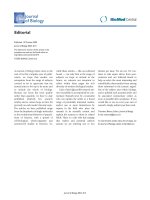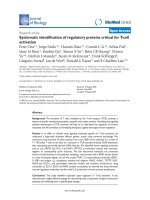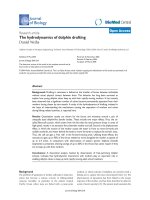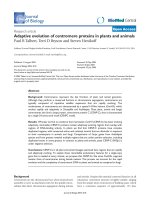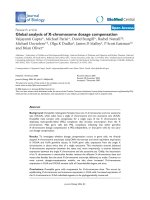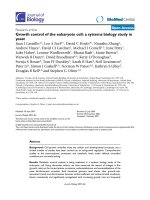Báo cáo sinh học: "Phenotypic plasticity of body pigmentation in Drosophila: Expression a of X chromosome fragility in Holstein-Friesian cattle: preliminary study" ppsx
Bạn đang xem bản rút gọn của tài liệu. Xem và tải ngay bản đầy đủ của tài liệu tại đây (503.01 KB, 7 trang )
Original
article
Expression
of
X
chromosome
fragility
in
Holstein-Friesian
cattle:
a
preliminary
study
G
Rincón.
S
Llambí,
A
Postiglioni
Laboratorio
de
Citogenética
de
Animales
Domésticos,
Area
Genética,
Departamento
de
Biología
Molecular
y
Celular,
Facultad
de
Veterinaria,
Lasplaces
1560,
Montevideo,
Uruguay
(Received
17
December
1996;
accepted
25
June
1997)
Summary -
Twenty
Uruguayan
Holstein-Friesian
cows
were
cytogenetically
examined,
focusing
on
Xq
3.1
fragility
manifestation
(Fra
Xq).
Comparative
culture
media
studies
were
carried
out
by
simultaneously
culturing
blood
samples
in
TC
199
and
RPMI
1640
media.
Taking
into
account
that
X
chromosome
aberrations
may
be
interfering
with
fertility,
the
cattle
population
were
also
evaluated
for
their
reproductive
performance.
One
thousand
metaphase
spreads
were
studied
in
each
culture
media
and
showed
normal
chromosome
constitution
in
most
cells.
Frequency
of
Xq
fragility
detected
in
TC
199
was
0.9%
while
in
RPMI
1640
it
was
1.8%
(0.05
>
P
>
0.01).
According
to
reproductive
performance,
repeat
breeders
manifested
92%
of
all
Fra
Xq
detected.
The
differences
in
expression
in
both
tissue
culture
media
and
the
frequencies
of
the
Xq
fragility
observed
in
cattle
with
reproductive
problems
are
discussed.
fragile
X
/
cattle
/
cytogenetics
/
fertility
Résumé -
Étude
préliminaire
sur
l’incidence
de
la
fragilité
du
chromosome
X
en
race
bovine
Holstein.
Vingt
vaches
de
race
Holstein-Friesian
Uruguayenne
ont
été
examinées
cytogénétiquement
pour
apprécier
la
fragilité
Xq
3.1
(Fra
Xq).
Une
étude
comparative
entre
les
milieux
de
culture
a
été
menée
par
culture
simultanée
des
échantillons
sanguins
dans
le
smilieux
TC
199
et
RPMI
1640.
En
raison
de
l’incidence
possible
des
aberrations
du
chromosome
X
sur
la
fertilité,
les
animaux
ont
été
aussi
évalués
pour
leur
performance
reproductive.
Mille
métaphases
ont
été
étudiées
dans
chaque
milieu
de
culture
et
la
majorité
des
cellules
a
montré
une
constitution
chromosomique
normale.
La
fragilité
Xq
exprimée
dans
le
milieu
TC
199
a
été
de
0,9
%
tandis
que
dans
le
milieu
RPMI
1640
elle
a
été
de
1,8
%
(0, 05
>
p
>
0, Ol). En
ce
qui
concerne
la
reproduction,
les
vaches
infertiles
ont
exprimé
9!
%
de
tous
les
Fra
Xq
détectés.
Les
différences
d’expression
dans
les
deux
milieux
de
culture,
ainsi
que
les
fréquences
observées
chez
les
vaches
présentant
des
problèmes
de
reproduction
sont
discutées.
X
fragile
/
bovin
/
cytogénétique
/
fertilité
*
Correspondence
and
reprints
INTRODUCTION
Cytogenetic
studies
of
cattle
herds
are
very
important
as
they
permit
the
estab-
lishment
of
associations
between
karyotype
and
phenotype
in
cases
of
hereditary
defects
including
reproductive
performance.
Recently,
X
chromosome
fragility
(Fra
Xq)
has
been
observed
in
cattle
with
reproductive
problems
and
baldy
calf
syndrome
(El
Nahass
et
al,
1974;
Genest
and
Guay,
1979;
Hanada
and
Muramatsu,
1980;
Uchida
et
al,
1986).
In
humans,
on
the
other
hand,
an
important
fragile
X
site
(Fra
Xq
27.3)
has
been
related
to
a
particular
kind
of
mental
retardation,
the
Martin
Bell
syndrome
(Sutherland,
1977;
Laird,
1987;
Oostra
and
Willems,
1995).
Fragile
sites
may
be
distributed
in
the
majority
of
domestic
species
in
a
similar
way
as
for
humans.
In
order
to
establish
a
relationship
between
cattle
Fra
Xq
and
those
fragile
sites
described
in
humans,
Uchida
et
al
(1986)
conducted
a
cytogenetic
study
on
a
Holstein
cow
and
its
calf,
which
had
baldy
calf
syndrome.
As
an
approach
to
cattle
Fra
Xq
location,
the
authors
reported
an
achromatic
gap
on
the
bovine
X
chromosome
close
to
the
centromere
in
a
pale
staining
Q
band.
Further
studies
defined
the
Xq
fragility
in
Holstein-Friesian
cattle
on
a
G
negative
band
in
region
3.1
on
the
long
arm.
This
structurally
abnormal
X
chromosome
expression
was
observed
in
cell
cultures
performed
in
RPMI
1640
medium
(Llambi
and
Postiglioni,
1994,
1996).
Nevertheless,
the
human
Xq
(27.3)
fragility
was
observed
only
when
lymphocytes
were
cultured
in
medium
TC
199,
deficient
in
folic
acid
and
not
in
several
other
available
culture
media
(Sutherland,
1977).
Generally,
fragile
sites
are
expressed
in
response
to
folate
deficiency
or
to
treatments
with
other
chemicals
such
as
aphidicolin,
azacytidine,
distamycin
A
and
bromodeoxyuridine.
Most
of
them
are
closely
linked
to
folate
metabolism
(Sutherland
and
Hecht,
1985).
As
observed
in
previous
investigations,
Fra
Xq
3.1
in
cattle
also
occurs
in
cultures
where
the
fragility
has
not
been
induced
by
chemicals
(Llambi
and
Postiglioni,
1994,
1996;
Postiglioni
et
al,
1996).
In
search
of
better
understanding
of
Fra
Xq
manifestation
in
Holstein-Friesian
cattle,
we
performed
a
comparative
culture
media
study.
Cytogenetic
examination
was
conducted
by
simultaneously
culturing
bovine
blood
samples
in
TC
199
and
RPMI
1640
media.
Taking
into
account
that
X
chromosome
aberrations
may
be
interfering
with
fertility
(Tewari
et
al,
1987;
Basrur,
1994;
Rinc6n
et
al,
1995),
cattle
population
in
this
study
was
evaluated
according
to
its
reproductive
performance.
Reproductive
traits,
such
as
calving
interval,
days
open,
and
services
per
conception
were
considered.
The
differences
in
incidence
of
Fra
Xq
in
both
tissue
culture
media
and
the
frequencies
observed
in
cattle
with
reproductive
problems
were
statistically
evaluated.
MATERIALS
AND
METHODS
Twenty
Holstein-Friesian
cows
from
different
dairy
farms
in
Uruguay
were
submit-
ted
to
karyotypic
analyses,
focusing
on
the
expression
of
Xq
fragility.
Each
blood
sample
was
drawn
from
the
coccigean
vein
into
a
heparinized
syringe,
and
cultured
in
vitro
for
72
h
according
to
a
modified
protocol
(Halnan,
1989).
Whole
blood
from
each
animal
was
cultivated
in
RPMI
1640
(Sigma)
and
TC
199
(Sigma)
media,
supplemented
with
20%
fetal
bovine
serum,
penicillin
(100
IU/mL),
streptomycin
(100
pg/mL),
and
phytohaemagglutinin
(0.2
pg/mL).
Colchicine
(0.004
mg/mL)
was
added
2
h
before
harvesting
the
cultures.
Folic
acid
concentration
in
TC
199
was
1
x
10-
5
mg/mL,
while
in
RPMI
1640,
it
was
1
x
10-
3
mg/mL.
Both
media
were
thymidine
free.
All
material
was
analyzed
with
standard
Giemsa
staining
(pH
6.8).
A
total
of
2
000
cells
were
cytogenetically
studied
in
order
to
compare
Xq
fragility
expression.
The
karyotypic
study
was
conducted
by
evaluating
50
metaphase
spreads
per
animal
for
each
culture
medium.
The
animals
were
divided
into
two
groups,
taking
into
account
the
reproductive
performance
of
each
animal.
Twelve
cows
were
culled
as
repeat
breeders
owing
to
repeated
breeding,
long
calving
intervals
and
abortions
(group
A)
and
eight
cows
were
considered
as
controls
owing
to
their
normal
reproductive
performance
(group
B).
In
both
cases
reproductive
traits,
including
calving
interval,
days
open
and
services
per
conception
were
evaluated.
The
Chi
square
test
was
used
to
establish
the
statistical
significance
between
the
level
of
Fra
Xq
occurrence
in
both
culture
media
and
in
both
groups
A
and
B.
RESULTS
The
results
of
cytogenetic
investigations
are
shown
in
table
I.
Most
cells
presented
normal
chromosome
constitution
without
any
structural
abnormality.
Fra
Xq
was
the
main
chromosome
alteration
in
27
metaphases,
and
in
all
cases
a
normal
female
complement
2n
=
60,
XX
was
detected.
Chromatid
breaks,
simple
gaps
and
chromosome
breaks
of
Xq
were
found
under
both
culture
conditions
(fig
la,
b).
They
were
all
detected
in
only
one
of
the
chromatids
except
for
one
metaphase
plate
where
fragility
was
observed
in
both
chromatids.
The
occurrence
of
Fra
Xq
in
group
B,
for
both
tissue
culture
media,
did
not
exceed
the
level
of
2%.
On
the
other
hand,
in
group
A,
the
occurrence
of
fragility
ranged
from
0%
(detected
in
four
animals)
and
14%.
In
RPMI
1640
medium,
six
repeat
breeders
out
of
12
expressed
Fra
Xq
at
a
frequency
of
2-14%
of
the
cells
with
a
mean
value
of
2.8%,
SD
=
2.2
(table
I).
In
TC
199
medium,
four
out
of
12
cows
manifested
Fra
Xq
at
a
frequency
of
2-6%
with
a
mean
value
of
1.3%,
SD
=
1.5
(table
I).
Reproductive
trait
data
are
shown
in
table
II.
Chi
square
test
revealed
statistical
significance
(0.05 >
P
>
0.01)
when
we
considered
the
difference
between
Fra
Xq
expression
in
both
culture
media.
Taking
into
account
the
reproductive
performance,
the
Chi
square
test
between
groups
A
and
B
also
showed
a
significant
difference
(P
<
0.001).
DISCUSSION
Although
the
majority
of
fragile
sites
are
revealed
in
response
to
external
culture
conditions,
some
occur
independently.
Fra
Xq
in
humans
is
rarely
expressed
under
normal
culture
conditions,
and
is
dependent
on
external
factors
including
the
cultivation
of
cells
in
folate-deficient
medium
(Glover,
1981;
Sutherland
and
Hecht,
1985).
Manifestation
of
Fra
Xq
in
cattle,
as
observed
in
this
preliminary
study,
did
not
show
a
higher
level
of
expression
in
TC
199
compared
to
RPMI
1640.
On
the
contrary
we
observed
an
enhanced
fragility
expression
in
the
latter
tissue
culture
medium
(0.05
>
P >
0.01).
The
percentage
of
Fra
Xq
expression
in
RPMI
1640
was
1.8%
while
in
TC199
it
was
0.9%.
Moreover,
X
fragility
ranged
among
individuals
in
RPMI
1640
medium
from
0
to
14%
compared
to
0-6%
in
TC
199.
These
differential
findings
support
the
conclusion
that
Fra
Xq
3.1
does
not
represent
a
common
folate-
sensitive
fragile
site.
The
enhanced
expression
observed
in
RPMI
1640
is
a
feature
shared
by
some
aphidicolin
inducible
fragile
sites
(Sutherland
and
Hecht,
1985).
Therefore
a
study
of
Fra
Xq
expression
under
this
chemical
inductor
is
also
required
to
reach
a
definitive
conclusion.
Chromatid
breaks
were
observed
as
the
main
form
of
chromosome
fragility.
Gaps
and
chromosome
breaks
were
also
observed,
but
in
a
lower
proportion,
which
is
in
agreement
with
our
previous
reports
(Llambi
and
Postiglioni,
1996).
Data
gathered
from
cytogenetic
investigations
of
domestic
animals
show
that
changes
affecting
one
of
the
sex
chromosomes
(X
chromosome)
tend
to
affect
the
form
and/or
the
function
of
the
reproductive
system.
The
animals
are
able
to
develop
a
normal
phenotype
but
become
subfertile
or
infertile
depending
upon
the
type
of
chromosome
defect
sustained.
The
adverse
effect
of
a
chromosome
defect
is
expressed
in
monotocous
animals
as
an
increased
interval
between
parturitions
and
reduced
rates
of
non-
return
for
services
after
artificial
insemination
(Basrur,
1994;
Long,
1984,
1990).
Xq
fragility
in
repeat
breeders
represented
92%
of
all
Fra
Xq
detected.
In
spite
of
that,
we
can
not
claim
that
Fra
Xq
is
the
direct
cause
of
decreased
reproductive
efficiency
in
group
A,
but
it
must
be
considered
as
a
possible
cause
of
repeat
breedings,
long
calving
intervals
and
abortions
in
individual
cases.
These
assessments
both
agree
with
and
reinforce
previous
cases
presented
in
the
literature
in
which
X
chromosome
fragility
is
directly
related
to
reproductive
problems
(El
Nahass
et
al,
1974;
Guenest
and
Guay,
1979;
Hanada
and
Muramatsu,
1980).
I
Undoubtedly,
future
studies
of
fragile
X
in
cattle
will
be
possible
due
to
progress
in
the
developing
construction
of
the
physical
map
and
its
functional
analysis.
Although
mapping
of
the
X
chromosome
has
been
limited
to
a
small
number
of
genes,
DMD
and
DXS19
markers
are
involved
in
region
3.1
(Barendse
et
al,
1994;
Eggen
and
Fries,
1995).
The
application
of
different
molecular
techniques
would
help
us
to
better
understand
chromosome
X
fragility.
ACKNOWLEDGMENTS
The
authors
wish
to
thank
to
Maria
Victoria
Arruga
for
critical
reading
of
the
manuscript.
This
paper
was
supported
by
project
P022/94
BID
CONICYT
(Uruguay)
and
CSIC
(Universidad
de
la
Rep6blica).
REFERENCES
Barendse
W,
Armitage
S,
Kossarek
L,
Shalom
A,
Kirkpatrick
B,
Ryan
A,
Clayton
D,
Li
L,
Neibergs
H,
Zhang
N,
Grosse
W,
Weiss
J,
Creighton
P,
McCarthy
F,
Ron
M,
Teal
A,
Fries
R,
McGraw
R,
Moore
S,
Georges
M,
Soller
M,
Womack
J,
Hetzel
D
(1994)
A
genetic
linkage
map
of
the
bovine
genome.
Nature
Genetics
6,
227-235
Basrur
P
K
(1994)
Contributions
of
cytogenetics
to
animal
reproduction:
Past,
present
and
future.
Rev
Bras
Reprod
Anim
18,
153-175
Eggen
A,
Fries
R
(1995)
An
integrated
cytogenetic
and
meiotic
map
of
the
bovine
genome.
Anim
Genet
26,
215-236
El-Nahass
E,
Syrjalla
A,
Michel-Mann
H,
Paufler
S
(1974)
Mosaik
einer
X-chromosomen-
Aberrations
als
wahrscheinliche
Ursache
der
sterilitat
bei
eimen
rind.
dt.
Tierarztl
Wscr
81,
405-406
Genest
P,
Guay
P
(1979)
Structural
abnormalities
of
X-chromosome
in
a
heifer.
Can
J
Comp Med 43,
110-11
1
Glover
T
(1981)
FUdR
induction
of
the
X
chromosome
fragile
site:
evidence
for
the
mechanism
of
folic
acid
and
thymidine
inhibition.
Am
J
Hum
Genet
31,
136-148
Halnan
C
R
(1989)
Cytogenetics
of Animals.
University
of
Sydney
Press
Hanada
H,
Muramatsu
S
(1980)
A
case
of subfertile
cow
with
structural
abnormalities
of
the
X
chromosome.
Ann
Genet
S61
Anim
12,
209-213
Laird
C
(1987)
Proposed
mechanism
of
inheritance
and
expression
of
the
human
fragile
X
syndrome
of
mental
retardation.
Genetics
117,
587-599
Llambi
S,
Postiglioni
A
(1994)
Localization
of
the
fragile
X
chromosome
break
points
in
Holstein-Friesian
cattle
(Bos
taurus).
Theriogev,ology
42,
789-794
Llambi
S,
Postiglioni
A
(1996)
Frequencies
and
cytomorphological
manifestation
of
sexual
X
chromosome
fragility
(Fra
Xq
3.1)
in
Holstein-Friesian.
Archiv
Zootec
45,
203-208.
Long
S
(1984)
Autosomal
trisomy.
Vet
Record
115, 16-17
Long
S
(1990)
Chromosomes
of
sheep
and
goat.
Adv
Vet
Sci
Comp
Med
34,
109-129
Oostra
B,
Willems
P
(1995)
A
fragile
gene.
BioEssays
17,
941-947
Postiglioni
A,
Llambi
S,
Gagliardi
R,
de
Bethencourt
M
(1996)
Genetic
characterization
of
uruguayan
creole
cattle.
I
Cytogenetic
characterization
of
a
sample
of
uruguayan
creole
cattle.
Archivos
de
Zootecnia
45,
209-213
Rinc6n
G,
Llambi
S,
Postiglioni
A
(1995)
Evidence
of
Xq
3.1
fragility
in
a
sample
of
Holstein-Friesian
cattle
with
reproductive
problems.
In:
Anais
do
XI
Congreso
Brasileiro
de
Reproducao
Animal,
10
a 14
de
julho
de
1995,
Colegio
Brasileiro
de
Reproducao
Animal,
Belo
Horizonte,
Brasil,
259
Sutherland
G
(1977)
Fragile
sites
on
human
chromosomes: Demonstration
of
their
depen-
dence
on
type
of
tissue
culture
medium.
Science
197,
265-266
Sutherland
G,
Hecht
F
(1985)
Fragile
Sites
on
Human
Chromosomes,
Vol
13.
Oxford
University
Press,
New
York
Tewari
R,
Juyal
R,
Thelma
B,
Das
B,
Rao
S
(1987)
Folate-sensitive
fragile
site
on
the
X-chromosome
heterochromatin
of the
Indian
mole
rat
Nesokia
indica.
Cytogenetic
Cell
Genet
44,
11-17
Uchida
Y,
Freeman
V,
Basrur
P
(1986)
The
fragile
X
in
cattle.
Am
J
Med
Genet
23,
557-562

